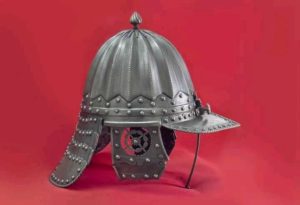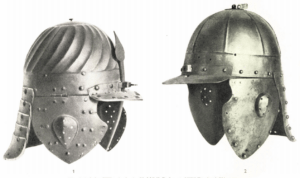Hungarian Lobster Tail Helmets
Look at this typical Hungarian Lobster Tail Helmet from all angles, displayed in the Haáz Rezső Museum (in Székelyudvarhely, Romania).

Lobster Tail Helmet aka “Rákfarkas sisak”, without ear-pieces. (16–17th century, length: 41 cm, height: 30 cm, diameter: 20 cm, weight: 3,6kg)
It is indeed a fact that this kind of Lobster Tail Helmet was created in this final form in Hungary and then it was spread in the world from here. Yet, the question is more difficult than that.
The Eastern Roots of the Lobster Tail Helmet
Historians reach back as far as the Mameluk Empire whose soldiers were able to stop the Mongolian invasion. It may not be known, though, that the Mameluks had been originally Cuman mercenaries who were formidable warriors of the 13th century.
We know that the Mameluk heavy cavalry was using the initial, Eastern forms of Lobster Tail helmets in the middle of the 13th century. The Ottomans were impressed by these warriors and took over many things from them. Soon, we can see that the Turks were using so-called onion-shaped helmets in the 15th century. The Ottoman warriors wore mostly chainmail under the onion-shaped helmet that protected their neck against the cuts – but not against the blows.

The revolutionary invention of the Lobster Tail could only solve this problem, providing further protection by the earpiece and the nosepiece. There was a screw that fixed the nose-piece to the helmet: it was a revolutionary invention, too. This allowed the warrior to remove the nosepiece when he wanted to eat or drink: he didn’t have to take off the whole helmet to do so. These helmets appeared first in Hungary.
The inventions made by the Hungarians
The Hungarians are said to have made the above-mentioned inventions on the Ottoman helmets and later “borrowed the fashion back” and copied it. While the Ottomans originally didn’t have the same facial part, the Hungarians had it. Before, the Hungarians had also used a “salap” in 1540-1550, similar to the picture in the book of Dselálzáde Mustafa (1500-1567):

However, the Ottoman Sipahies called their helmets “chichak” (meaning “onion”). Also, “sisak” means “helmet” in the Hungarian language. During the centuries of wars between the Hungarians and the Ottomans, the Hungarians have gained lots of Ottoman trophies of war since the end of the 14th century. They came to like the flexible but strong Ottoman helmets and decided to create their own ones. Allegedly, the early forms of this helmet were in use by the Hungarians in the mid-15th century.
Even John Hunyadi was said to have used the early forms of Lobster Tail helmets. Many illustrations from the 16th century show him wearing that kind of helmet. In Hungary, this helmet became common in the 16th century, even the infantrymen used it.

All in all, the Hungarian helmet is an in-between product between the Burgundian style helmet that had strong but rigid neck protection and the Ottoman helmet of the Mameluks. Note, that a similar process can be observed regarding the development of Hungarian sabers. Below, you can see a Hungarian lobster-tail helmet, iron, 17th century, it is on display in the Museum of Vrsac, Bánát (Banate) Region, Serbia.

The final development of Hungarian helmets
In the second half of the 16th century, the appearance of the hussar’s helmet changed significantly. The bell gradually lost its conical shape, its height decreased and the remaining conical shape began to lose its oriental character. It became more and more hemispherical, like the shape of the head. In the third quarter of the century, the protruding apex of the skull is completely blunted and takes on the shape of a high semicircle, the surface of which is covered with a dense groove running along its ridge or length, and the neck of which is made up of flexible bands of superimposed plates. However, the protective panels that defended the ears are still large and not symmetrical. The sides of the face are almost completely covered, with only the part towards the eyes showing notches.

By the end of the century, the earlobes had become symmetrical, bounded by a circular arc and elongated triangles. They no longer had a heart-shaped protrusion and were replaced by a series of circular openings. The visor often leapt forward in a bold point, but the narrow cheekpiece remained externally unchanged.

This was the end of the Hungarian helmet’s glorious career. This type of helmet, with its advantageous protective features, also found a place in Western armies, and at the end of the 16th century, around 1590, the word “helmet” itself was introduced into the German language in the form of “Zischägge”.
During the Thirty Years’ War, the Hussars, who were equipped with western half armor, which in our eyes was heavy cavalry, but in the Western sense could be classified as light cavalry, continued to wear the Hungarian lobster tail helmet as the only and proven protective armor used in the West, but after the end of the war it disappeared from the equipment of our Hussars.
The Lobster Helmets abroad
By the middle of the 17th century, the Hungarians were not using this helmet so frequently, it was the time when the Austrians took it over. By the early 18th century, they had shortened the Lobster Tail a little and painted it black, but still called it “zischagge” as we had mentioned it.
The Polish-style helmets began their development at the end of the 16th century when Báthori István became the king of Poland and Lithuania. Two forms were very common in the early years of the 17th century: in the first type, the helmet’s top was entirely flexibly put together from 13 metal strips while the other had a metal fin on its top.
In England, Oliver Cromwell improved the helmet’s nose-piece by making it adjustable when he introduced it in his cavalry. This helmet played an important role in the 30-Year War as well.

Source: Arcanum https://www.arcanum.hu/hu/
Dear Readers, I can only make this content available through small donations or by selling my books or T-shirts.
If you like my writings, please feel free to support me with a coffee here:
You can check out my books on Amazon or Draft2Digital, they are available in hardcover, paperback, or ebook:
https://www.amazon.com/dp/198020490X
or at https://books2read.com/b/boYd81


My work can also be followed and supported on Patreon: Become a Patron!http://Become a Patron!


